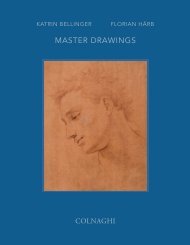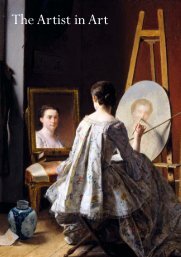2007 Catalogue - Colnaghi
2007 Catalogue - Colnaghi
2007 Catalogue - Colnaghi
You also want an ePaper? Increase the reach of your titles
YUMPU automatically turns print PDFs into web optimized ePapers that Google loves.
Provenance: Reginald Vaile, Esq.; Christie's, London,<br />
23 May 1903, lot 37 (£2,625 to Agnew's); Charles<br />
Fairfax Murray; Galerie Georges Petit, Paris, 15 June<br />
1914, lot 18; Mr. and Mrs. Charles F. Williams,<br />
Cincinnati and thence by descent until 2005.<br />
Literature: G. Wildenstein, Lancret, Paris, 1924,<br />
p. 81, no. 145, fig. 207.<br />
Exhibited: London, Guildhall Art Gallery, <strong>Catalogue</strong><br />
of the Exhibition of a Selection of Works by French and<br />
English Painters of the Eighteenth Century, 1902, p. 40,<br />
no. 35; Glasgow, 1902; San Francisco, The California<br />
Palace of the Legion of Honor, Exhibition of French<br />
Painting, from the Fifteenth Century to the Present Day,<br />
1934, p. 38, no. 35.<br />
This delightful duet by Nicolas Lancret had been lost<br />
to public view for the better part of a century. It was<br />
recorded (under cat. 145, fig. 207) among paintings<br />
he had not seen by Georges Wildenstein in his 1924<br />
catalogue raisonné of this artist. 1<br />
The composition is beautifully arranged, a classic fête<br />
galante. The five elegant figures are arranged with<br />
Lancret's trademark grasp of composition - the five<br />
figures rise and fall in a graceful rhythm across the<br />
front plane, with the main female dancer silhouetted<br />
against the sky, the lovers' graceful curve carving out<br />
the right side and the hurdy-gurdy player carefully<br />
framed by the menuet. The inscription on the back is<br />
in a nineteenth-century hand, but must be based on<br />
an earlier inscription, as the information therein seems<br />
entirely correct. That inscription dates this work to<br />
1732. The 1730s was a decade of great maturity in<br />
Lancret's work. The composition of Le Menuet, with<br />
the reduced number of figures pushed forward to the<br />
picture plane and all large within the space of the<br />
painting, is typical of this period. This painting invites<br />
comparison with other fine examples of the artist's<br />
work of this time, such as Les Amours de Bocage (Alte<br />
Pinakothek, Munich) or Le Jeu de Quilles (owned by<br />
Frederick the Great, one of Lancret's most ardent<br />
admirers, and today in Schloss Charlottenburg, Berlin).<br />
The subject, a beautiful dance, is characteristic of<br />
Lancret at his best. The dancing girl bears close<br />
17<br />
Nicolas Lancret<br />
(Paris 1690 – 1743 Paris)<br />
Le Menuet<br />
Inscribed by a nineteenth century hand on the reverse: ‘Danse Champêtrê… peint par m’ Lancret peintre du roy en 1732<br />
la tête du jour et de l’academie de vielle est le portrait de M’Mestais avocat au parlement.’<br />
Oil on canvas<br />
29 x 34 1 /4 in. (73.7 x 87 cm.)<br />
56<br />
resemblance to the two seminal portraits of dancers<br />
made by Lancret just a few years prior, those of<br />
La Camargo (for example the elaborate version in the<br />
National Gallery, Washington D.C., and the simpler<br />
version in The Wallace Collection, London) and Mlle<br />
Sallé (Schloss Rheinsburg). She, like they, testify to the<br />
importance of the female dancer in Lancret's work,<br />
and, indeed, of dance at the time. She is a fine example<br />
of the use of his favourite source material, the<br />
seventeenth- and early eighteenth-century French print<br />
tradition, especially the fashion plates and<br />
theatre/dance role images. Lancret drew from that well<br />
repeatedly, and this dancer with castagnets is based<br />
firmly on images such as Mlle. Du Fort dansant à<br />
l'Opera, published by André Trouvain in 1702. The<br />
dancing man is dressed in the ribbons of an actor, a<br />
device often used by Lancret to create a tension<br />
between the real world and the world of the stage in his<br />
paintings.<br />
One captivating aspect of the subject is the inclusion of<br />
the portrait of an existing person among these fictional<br />
creations. The initial head of the hurdy-gurdy player<br />
has been painted over and replaced with a portrait, a<br />
very distinct likeness. Lancret experimented with<br />
placing portraits within fêtes throughout his career,<br />
certainly inspired by the example of Watteau, who<br />
included portraits of members of his circle in some of<br />
his fêtes; the figure of Crispin, for example, to the far<br />
right of Love in the French Theatre (Gemäldegalerie,<br />
Berlin) is certainly a portrait, probably of the great<br />
actor Paul Poisson. 2 Lancret's concept here is actually<br />
closer to the Watteau work, the insertion of a true<br />
likeness within a theme that is not itself a work of<br />
portraiture. The idea must have come to Lancret late in<br />
the conception of this work, as the portrait appears to<br />
have been added over an existing head. One wonders<br />
if the painting might have been intended as a gift to<br />
the owner of that head, who is identified in the<br />
inscription as one M. Mestais, designated by the<br />
inscription on the back as an avocat au parlement.<br />
Report by Mary Tavener Holmes, who confirms the likely<br />
date of 1732.








